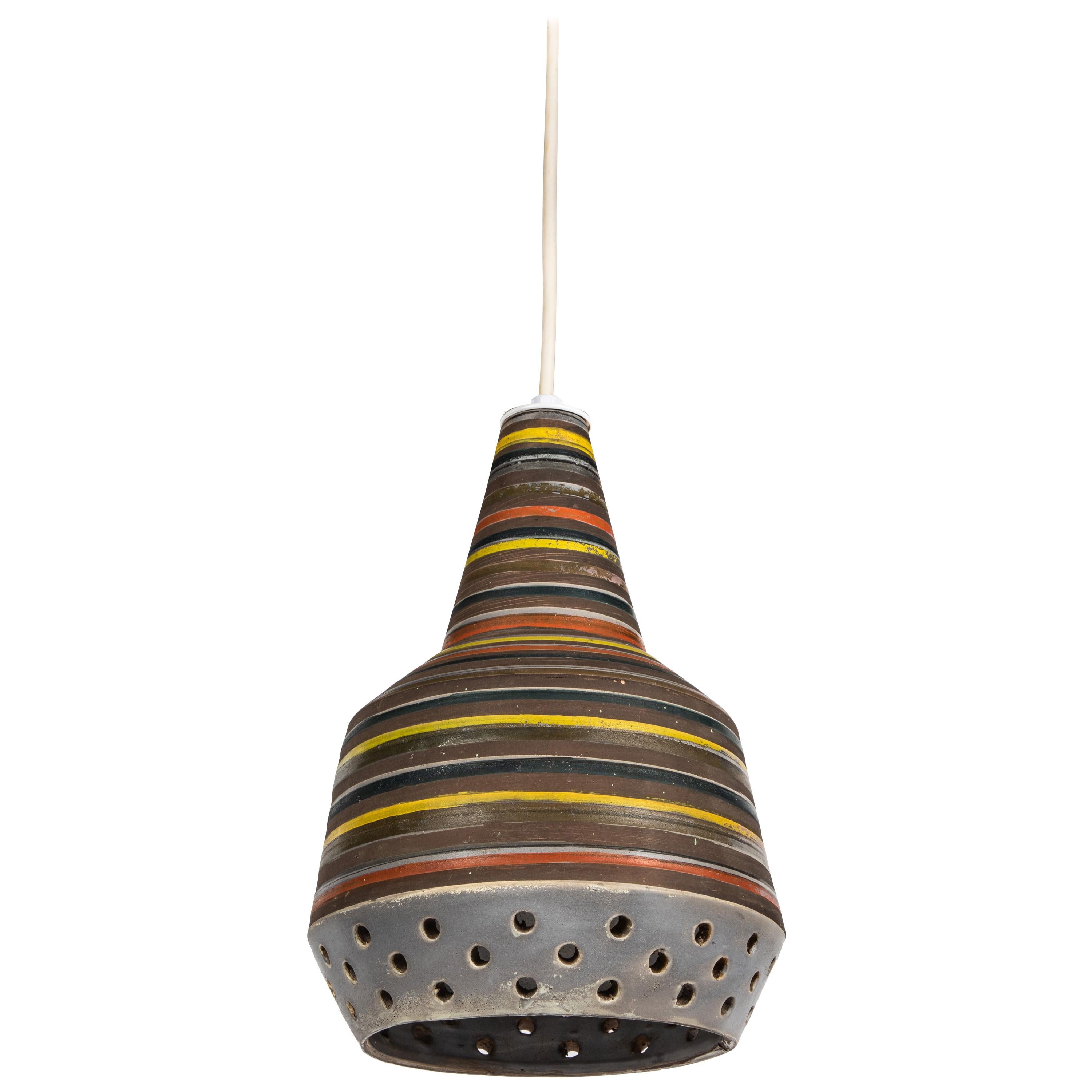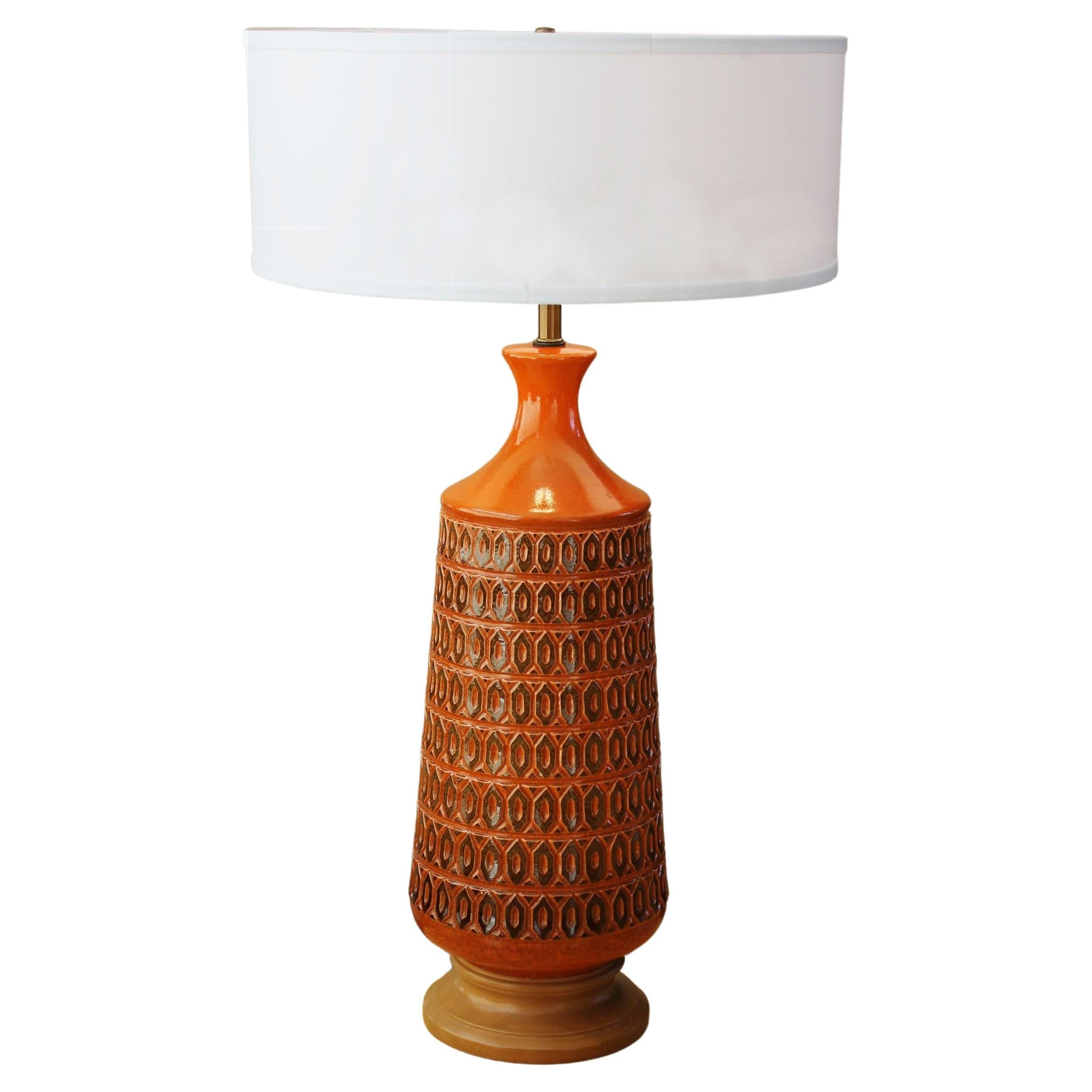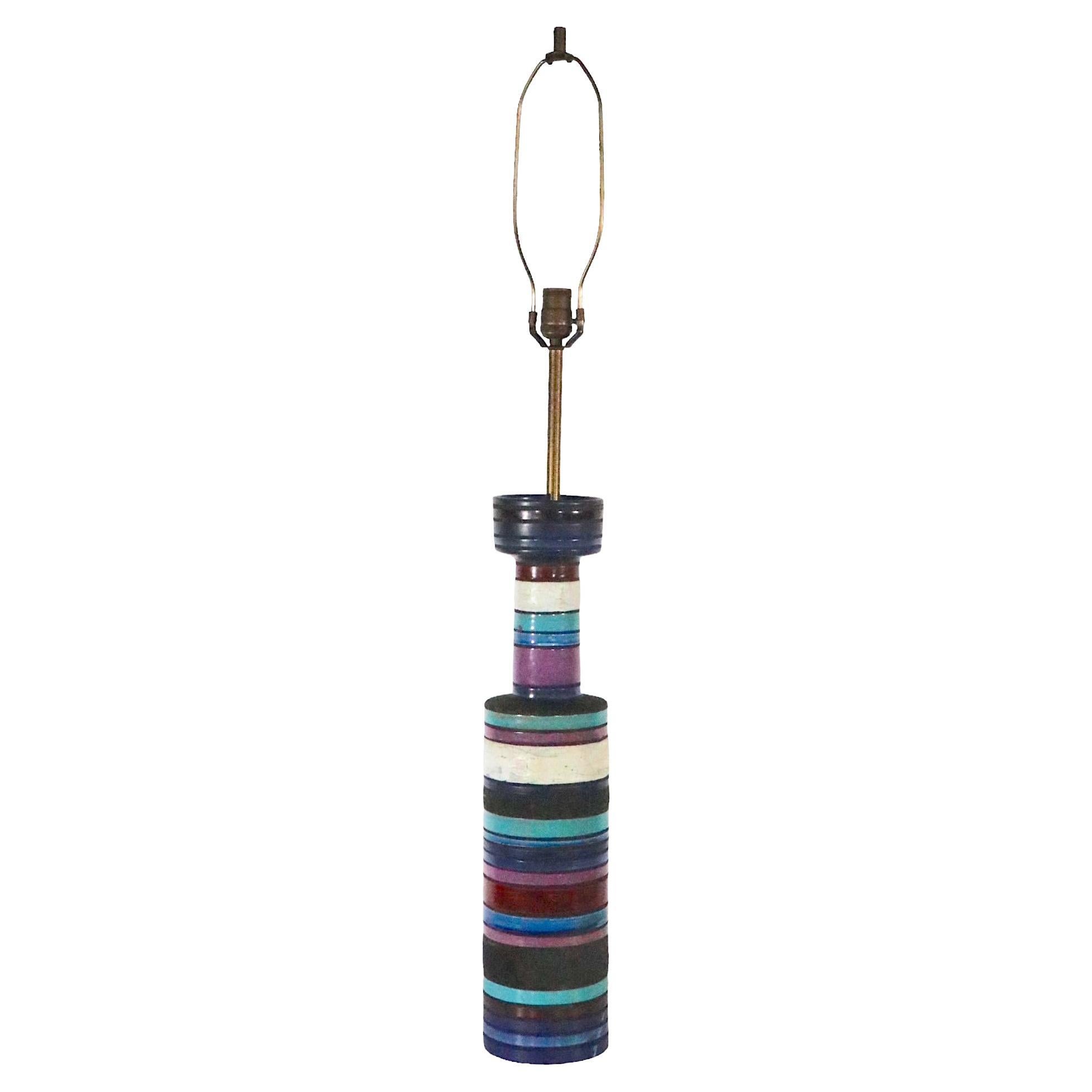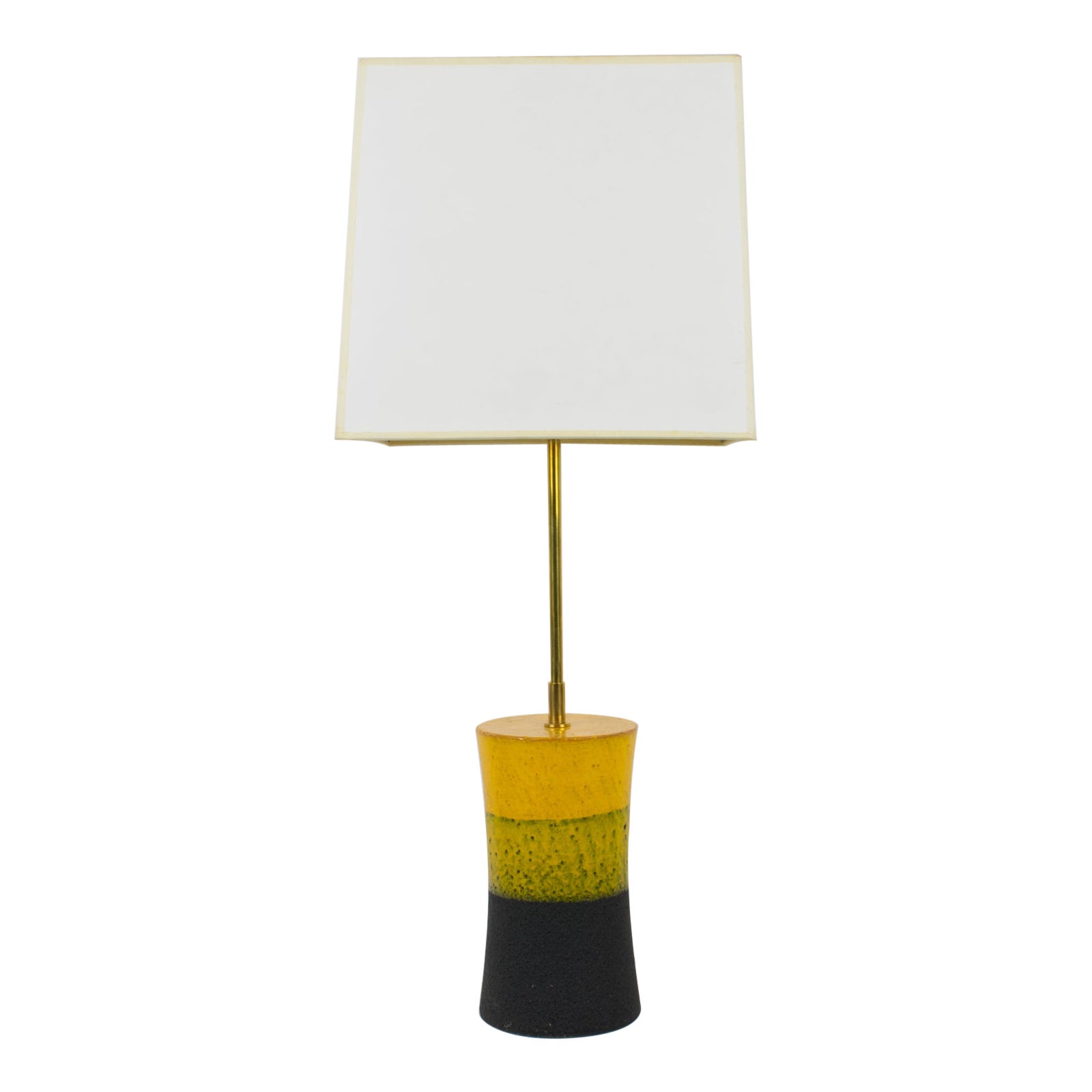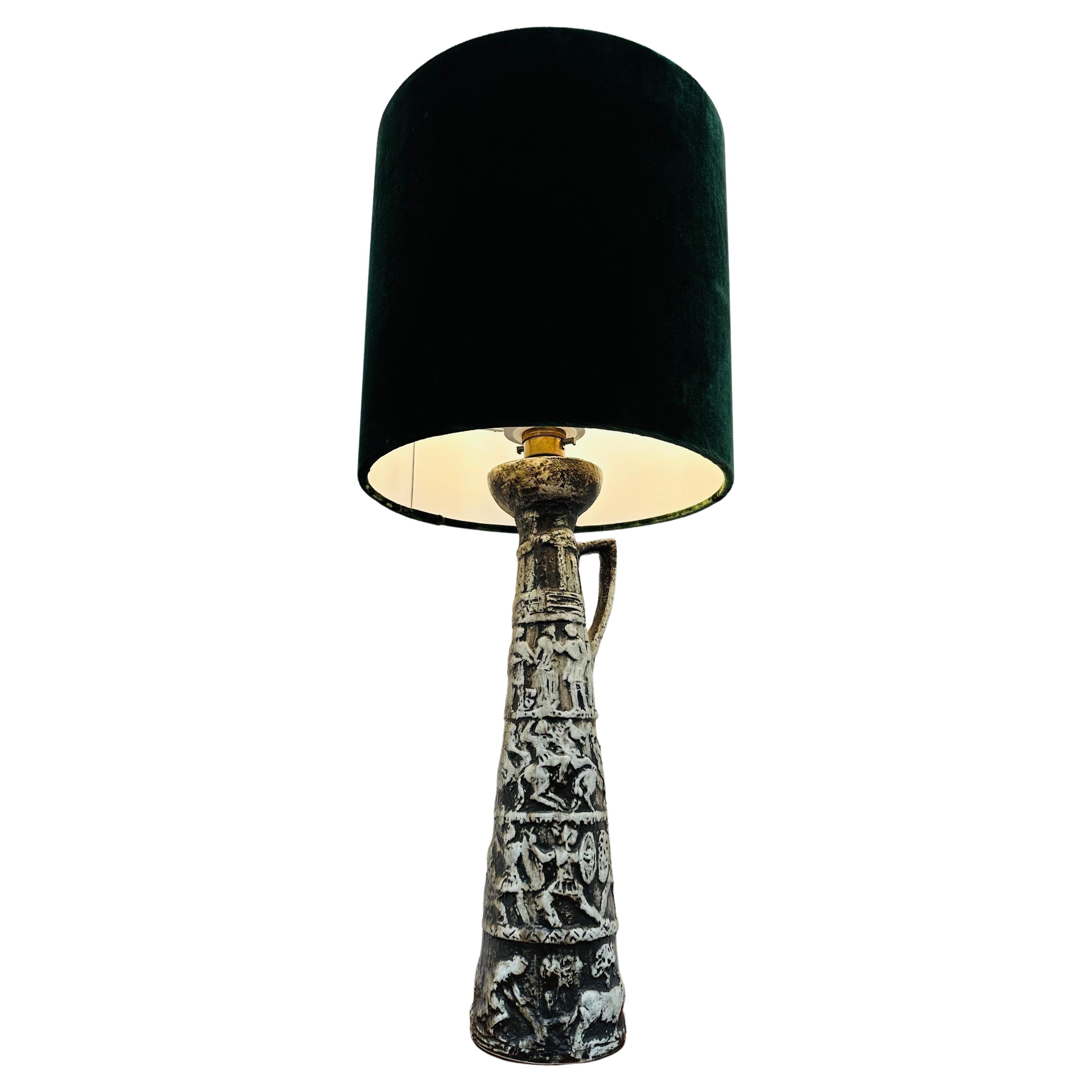1950s Aldo Londi Ceramic Bitossi Pendant Lamp for Italian Raymor
About the Item
- Creator:Raymor (Maker),Aldo Londi (Designer)
- Dimensions:Height: 8 in (20.32 cm)Diameter: 4.75 in (12.07 cm)
- Power Source:Hardwired
- Voltage:110-150v
- Lampshade:Included
- Style:Mid-Century Modern (Of the Period)
- Materials and Techniques:
- Place of Origin:
- Period:
- Date of Manufacture:1950s
- Condition:Rewired. Additions or alterations made to the original. Wear consistent with age and use. See description for details.
- Seller Location:Glendale, CA
- Reference Number:
Aldo Londi
Master Italian ceramist Aldo Londi created a range of decorative objects in the latter half of the 20th century for the manufacturer Bitossi. In addition to the small-scale animal sculptures for which he is best known, Londi designed a variety of ceramics for the famed company that includes vases, bowls and desk accessories. Collectors know that vintage Aldo Londi pottery is marked by deep attention to detail and an integration of rich, alluring hues typically associated with the Mediterranean.
Londi was born in Montelupo Fiorentino, just outside of Florence, an area that has been known for its pottery since the Renaissance. Londi showed an early interest in the craft, apprenticing at the Fratelli Fanciullacci ceramic workshop when he was only 11 years old. He worked at the company until he left to fight in World War II. After returning to Montelupo Fiorentino in 1946, Londi became the creative director at Bitossi — a position he held for more than 50 years.
Londi's fresh and unique style breathed new life into Bitossi. He prioritized the production of high-quality and handmade decorative objects and created many of Bitossi's pottery lines himself. The most famous of Londi's Bitossi collections is the Rimini Blu line of animals and vases, which debuted in 1955. The collection is characterized by geometric and whimsical patterns and is recognizable for its marvelous blue color.
Londi's fame and popularity extended outside of Italy with the help of Raymor. The American import and distribution company introduced many esteemed Italian manufacturers such as Bitossi to boutiques and department stores in the United States. After Raymor founder Irving Richards hired Ettore Sottsass to design ceramics, Richards connected his new recruit to Londi. Decades before he founded a legendary postmodern design collective in Milan called the Memphis Group, Sottsass used the Bitossi kilns to create timeless works that manifest both primitive forms and modern geometries.
In 2021, Bitossi opened the Bitossi Archive Museum at its Montelupo Fiorentino headquarters. Many of the works designed by the company's most esteemed contributor and artistic director, Aldo Londi, are proudly displayed.
On 1stDibs, find vintage Aldo Londi serveware, lighting, decorative objects and more.
- ShippingRetrieving quote...Ships From: Glendale, CA
- Return PolicyA return for this item may be initiated within 1 day of delivery.
- 1950s Aldo Londi Ceramic Bitossi Pendant Lamp for Italian RaymorBy Aldo Londi, RaymorLocated in Glendale, CA1950s Aldo Londi Ceramic Bitossi pendant lamp for Italian Raymor. This rare and sculptural Italian ceramic lamp is executed with multi colored glazed horizontal stripes and geometric circular perforations. Only one available in this coloration. Another similar lamps...Category
Vintage 1950s Italian Mid-Century Modern Chandeliers and Pendants
MaterialsCeramic
- 1960s Bitossi Rectangular Vase by Aldo Londi with SignatureBy Bitossi, Aldo LondiLocated in Glendale, CA1960s Bitossi rectangular vase by Aldo Londi with Signature. This rare and sculptural Italian ceramic vase is executed in green glazed ceramic with geometric floral embossing, black sides and rim. Signature on bottom of vessel. A refined yet whimsical design characteristic of the best Italian ceramics...Category
Vintage 1960s Italian Mid-Century Modern Vases
MaterialsCeramic
- 1950s Birger Dahl Pendants for SonnicoBy Sonnico, Birger DahlLocated in Glendale, CA1950s Birger Dahl Pendants for Sonnico. Rare set of three original edition pendants for Sønnico, Norway, circa 1954. Custom brass ceiling plates with 30" adjustable drop. Three pe...Category
Vintage 1950s Norwegian Scandinavian Modern Chandeliers and Pendants
MaterialsMetal, Brass
- 1950s Italian Glass Pendant Attributed to StilnovoBy StilnovoLocated in Glendale, CA1950s Italian glass pendant attributed to Stilnovo. Executed in opaline matte glass, brass and black painted metal. This scu...Category
Vintage 1950s Italian Mid-Century Modern Chandeliers and Pendants
MaterialsMetal
- 1950s Jo Hammerborg Pendant for Louis PoulsenBy Louis Poulsen, Jo HammerborgLocated in Glendale, CA1950s Jo Hammerborg Pendant for Louis Poulsen. Executed in black painted cylindrical metal with custom patinated brass canopy and thick black cloth cord, Denmark, circa 1950s. Price...Category
Vintage 1950s Danish Scandinavian Modern Chandeliers and Pendants
MaterialsMetal
- 1950s Bent Karlby Black Painted Metal & Brass Pendant Lamp for LyfaBy Lyfa, Bent KarlbyLocated in Glendale, CA1950s Bent Karlby Black Painted Metal & Brass Pendant Lamp for Lyfa. Executed in architecturally cut and elegantly shaped black painted metal shades with brass hardware, Denmark, cir...Category
Vintage 1950s Danish Scandinavian Modern Chandeliers and Pendants
MaterialsMetal, Brass
- Monumental 33" Raymor Italian Pottery Table Lamp! 1950s Aldo LondiBy Aldo Londi, RaymorLocated in Peoria, AZMagnificent! Stunning Orange Sculptured Italian Pottery Table Lamp For Raymor Attributed to Aldo Londi This sensational lamp is a testimony to the Italian pottery house of the mid...Category
Mid-20th Century Italian Mid-Century Modern Table Lamps
MaterialsMetal
- Raymor Cambogia Table Lamp by Aldo Londi for Bitossi, Imported by Raymor, 1950sBy Aldo Londi, BitossiLocated in New York, NYRare Aldo Londi designed Cambogia table lamp made in Italy by Bitossi, imported by Raymor, circa 1950s. The ceramic body features poly chrome stripes w...Category
Mid-20th Century Italian Mid-Century Modern Table Lamps
MaterialsCeramic, Pottery
- Aldo Londi for Bitossi Italian Modern Ceramic White, Blue Lamp, 1950sBy Aldo Londi, BitossiLocated in Copenhagen, DKHandmade and hand decorated Italian Mid-Century Modern textured chamotte ceramic table lamp. Designed by Aldo Londi for the collection "Rimini Blu" in 1959 and manufactured by Bitoss...Category
Mid-20th Century Italian Mid-Century Modern Table Lamps
MaterialsCeramic, Pottery
- Aldo Londi for Bitossi Italy Mondrian Design Ceramic Table Lamp, 1960sBy Aldo Londi, Bitossi, RaymorLocated in Atlanta, GAThis striking 1960s Aldo Londi for Bitossi geometric ceramic table lamp was imported and distributed in the United States by Raymor of New York. This table lamp features a "Mondrian" style design with a cylindrical geometric shape and a bright yellow semi-gloss enamel finish contrasted by a textured matte black. There is no visible maker's mark. For fifty years, Bitossi's creative director, Aldo Londi, brought the ceramics manufacturer into the modern era with his abstract motifs and vivid use of colors. The lamp does not come with the shade photographed (for in situ only purpose). The table lamp electricity was updated to fit US standards. The harp and finial are included with the lamp sale...Category
Vintage 1960s Italian Mid-Century Modern Table Lamps
MaterialsFaience, Ceramic
- 1950s Italian Aldo Londi for Bitossi Ceramic Pottery Medieval Frescos Table LampBy Aldo Londi, BitossiLocated in London, GB1950s Italian designed by Aldo Londi and manufactured by Bitossi ceramic pottery table lamp base. Following some research I believe it may have originally been a candlestick but conv...Category
Mid-20th Century Italian Mid-Century Modern Table Lamps
MaterialsBrass
- Aldo Londi, Bitossi Italian Ceramic LampsBy Aldo Londi, BitossiLocated in New York, NYPair of Italian hand decorated ceramic lamps feauring a light brown background and exhuberant stylized fauna and flowers in light blue, lilac, and celadon. Rewired for use in the USA...Category
20th Century Italian Mid-Century Modern Table Lamps
MaterialsCeramic
